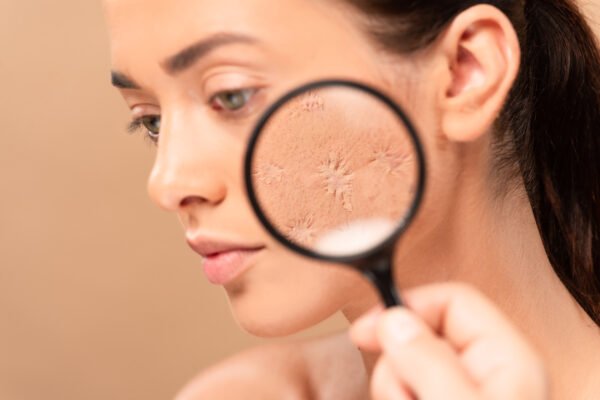Introduction
Do you regularly have greasy and dry face patches? Your situation isn’t unique. Due to its duality, combination skin confuses many. But fear not—this site is your definitive guide to understanding, managing, and embracing combination skin. You’ll learn how to choose the best combination of skin products, how to target particular issues, and more to tackle your skincare problems.
The characteristics of combination skin.
What is Combination Skin?
People with combination skin have parts of their face that are both oily and dry. In most people, the T-zone (forehead, nose, and chin) is sticky, but the lips are normal or dry. Because of this, it needs a well-balanced skincare program to meet all its different needs. Figuring out your skin type is essential for picking the correct goods and treatments for a healthy look.
Why Does Combination Skin Occur?
Having combination skin can be caused by your genes, your surroundings, and your hormones changing. Any of these things can cause your face’s oil and wetness levels not to spread out evenly. Knowing about these factors can help you control and tailor your skincare routine to meet the needs of people with combination skin.
Challenges of Combination Skin
Combination skin makes it hard to find products for oily and dry skin. The incorrect products can make skin oily or dry, worsening issues. Without assistance, it can be a delicate balance. Since oily regions collect bacteria and grime, combination skin is more likely to erupt. Proper skincare is even more critical for clear, healthy skin.
Tips for Managing Combination Skin
- Know your skin type: Before building a skincare routine, ensure you know which areas of your face are oily and dry. This will help you choose products that cater to those specific needs.
- Use gentle cleansers: Look for non-stripping or non-foaming cleansers that won’t irritate or dry out your skin. Avoid harsh ingredients like alcohol or fragrances.
- Moisturize properly: Use a lightweight moisturizer for your oily areas and a richer one for your dry areas. You can also try using different moisturizers on different parts of your face.
- Exfoliate regularly: Regular exfoliation helps remove dead skin cells and unclog pores, preventing breakouts. Use a gentle exfoliant 2-3 times a week to avoid over-exfoliation.
- Know when to treat oily and dry areas differently: If you have combination skin, targeting specific issues in each area of your face is essential. For example, oil-controlling products should be used in your T-zone whi, and hydrating products should be used on your cheeks.
Identifying Your Skin Type
You must know your skin type to care for mixed skin. After washing your face with a gentle cleaner, examine your skin an hour later. The test is simple. Is your T-zone shiny and cheeks tight? Then you probably have mixed skin. This self-test customizes your skincare routine.
Building the Perfect Skincare Routine
Start using a mild cleaner that removes dirt and oil without drying the face. To keep pH levels even, use a toner made for combination skin afterwards. A light lotion that keeps skin hydrated without closing pores is essential. No matter what kind of skin you have, don’t forget to put on sunscreen.
Choosing the Best Products for Combination Skin
Look for items with hyaluronic acid, which moisturizes without adding extra oil. Niacinamide, known to reduce swelling, is another vital ingredient for combination skin. Pick oil-free, non-comedogenic items to clear your skin and avoid clogged pores.
Exfoliating Wisely
Exfoliating is crucial to eliminating dead skin cells and keeping pores from getting plugged. Use a light cleanser once or twice weekly to clear the T-zone and avoid hurting dry skin. Look for effective but light cleansing products with salicylic acid or fruit enzymes.
Managing Oily and Dry Areas
Apply different products to different face sections. Use mattifying products on your T-zone and thick creams or serums on dry areas. Multi-masking—wearing several masks on different regions of the face—is common. It lets you meet each zone’s needs.
Seasonal Adjustments for Combination Skin
If you have this skin, seasonal skincare changes may be needed. Wintertime skin protection and hydration are essential. Choose lightweight, oil-controlling goods in summer. These modifications will help you maintain healthy skin year-round.
Common Mistakes to Avoid
Don’t use strong cleaners or items with alcohol because they can throw off your skin’s natural balance. Another common mistake is over-exfoliating, which can make the skin more sensitive and irritated. Follow the same skincare routine daily and be patient; it takes time for the skin to get better.
Maintaining a Healthy Combination of Skin
To keep your combination skin healthy, you need to be consistent. Follow your plan and only change things when you need to. Keep track of how your skin responds to different goods and changes in the surroundings. This will help you make intelligent choices about your skincare.
Lifestyle Factors Affecting Combination Skin
Lifestyle choices can significantly impact the skin. Stress, diet, and sleep affect skin health. Stress can cause hormone changes that aggravate oily or dry skin. A balanced diet of minerals, vitamins, and water can keep your face healthy. Sleeping enough helps your face repair and makes you seem younger.
The Role of Diet in Skincare
What you eat can change the way your face looks and feels. Foods high in sugar and fats may cause inflammation, which can cause acne in oily areas. On the other hand, eating more fruits, veggies, and healthy fats like omega-3s can feed and hydrate the skin from the inside out, making it more balanced generally.
Consultation with Skincare Professionals
While doing your skincare practice is important, talking to doctors or other skin care experts can also be very helpful. They can tell you about the best goods or treatments for your skin type so you can handle problems effectively and safely. Regular contact with a professional can help you stay on track and change your routine as needed.
Conclusion
This skin type is not bad. By learning about your skin’s demands and tailoring your cosmetics regimen, you may have a healthy, radiant face. Remember that every skin type has issues. You can care for combination skin if you know what to do and use the proper products. See a skin care specialist or visit informative web pages for further information.









